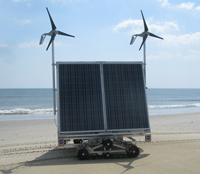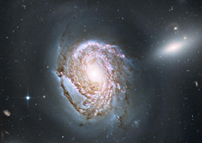Archive
Introducing Andy Hoffmaster and GROVER the rover
Post 1: Welcome to Engineering Boot Camp
Post 2: Introducing Andy Hoffmaster & GROVER the rover
Andrew (Andy) Hoffmaster is one of the dozens of interns working this summer in the Engineering Boot Camp at NASA’s Goddard Space Flight Center. He recently graduated from the Catholic University of America in Washington, D.C., with a degree in biomedical engineering
It’s Hoffmaster’s third year in Engineering Boot Camp. This year he has stepped up to a leadership role, supervising five different teams of interns who are working on a science robot called GROVER. In a time-honored NASA tradition, “GROVER” is a very impressive-sounding acronym: Goddard Remotely Operated Vehicle for Exploration and Research.
GROVER, in a nutshell, is a solar-and-wind-powered, caterpillar-tracked rover that carries a ground-penetrating radar device. It is designed to roam alone for months at a time measuring the thickness of the Central Greenland Ice Sheet, which is about the size of Texas. “The problem with sending people is that they run out of food and fuel too fast,” explains “NASA Mike” Comberiati, who runs the internship.
Someday, GROVER will crawl across frigid Greenland at up to 3 mph, 10 hours per day, for 4 months. NASA Mike and his interns are working with NASA cryosphere researchers Lora Koenig and Hans-Peter Marshall on the project. (Koenig is based at Goddard; Marshall is at Boise State University in Idaho.
Hoffmaster and GROVER have spent a lot of time together, although in his first year internship (2009), he didn’t work on GROVER at all. He designed and built the mechanical parts for a laser-scanning device on another robot, referred to as “the Mothership.” More on the Mothership in future posts, but you can take a quick look at her HERE.
GROVER 1 & 2
In his second internship season (2010), Hoffmaster started working on GROVER. He built the housing for the rover’s electronics. In January 2011, he accompanied Comberiati to McMurdo Station in Antarctica to help install and configure equipment to communicate with NOAA POES satellites.
GROVER 1 (shown in the video and images in this post) weighs about 700 pounds. Its solar panels and wind turbines — the spinning blades produce power when it’s cloudy — provide ample power. It has performed admirably in testing.
But GROVER 1 is too heavy and too big, and it takes too long and too much work to unload and assemble. This summer, the interns assigned to build a better GROVER.
GROVER 2.0 will be lighter and smaller. It will sport more efficient solar panels and a lower center of gravity to resist tip-overs in gusty Greenland winds. The rover will also gain software to allow it to operate without constant human monitoring, and to uplink data via the Iridium satellite network.
Also, GROVER 2 will be fabricated in three sections to enable rapid assembly by people wearing bulky cold-weather gloves. After all, standing around in the cold in Greenland can be a health hazard!
This, and more, will require the labor of five intern teams to design, build, and test the electrical components and systems (headed by Hoffmaster) and four mechanical teams (headed by senior intern Guillermo Diaz, a student at Tec de Monterrey in Mexico). It all has to happen in about 5 weeks’ time.
Last year’s crop of interns completed construction of GROVER 1, which today sits on the front lawn of Building 25 in Goddard’s wooded east Campus. The rover will serve this year as a test bed for some of GROVER 2’s new systems.
On the beach with GROVER
It was a chilly day, April 1, 2011. Hoffmaster and three other interns drove with NASA Mike down to Assateague State Park, with GROVER on a flatbed truck. While backing GROVER down the ramps onto the beach, they paused cautiously to check the rover’s orientation.
Then something weird happened, Hoffmaster says. One of the twin caterpillar tracks switched into full reverse and tipped GROVER off the ramps and onto the sand. Thankfully, the robot was unscathed except for a piece of bent metal.
The culprit: “anomalous cold bit.” To us non-specialists, that means that because of cold temperatures, the caterpillar track’s electronic controller sent an incorrect instruction. It’s just the sort of thing that can happen during the development of new technology, and the interns will work to solve it this summer.
On the beach, GROVER proved itself, with enough traction to drag Andy across the sand. Sand, it turns out, is close enough to snow (from GROVER’s point of view) to provide a decent simulation of the rover’s performance in Greenland. They tested it until 3:30 that afternoon and headed for home.
Andy says Engineering Boot Camp gave him valuable engineering insights and skills that he will be able to apply to his new job with Aretech in Dulles, Virginia, developing physical therapy equipment for rehabilitating stroke patients. He’ll work on a device called a “body weight support gait trainer.” It’s a harness on a motorized trolley track that supports patients safely as they re-learn how to walk after brain injury. “I took what I learned at Goddard and can apply it to human kinematics.”
That Was The Week That Was, August 9-13, 2010. . . A Digest of Goddard People, Science, & Media, PLUS Historical Tidbits and Our Best Stuff in the Blogpodcastotwittersphere
MONDAY AUGUST 9: NASA Earth Observatory has a new blog: Elegant Figures. . . EO’s lead data visualizer, Robert Simmon, will write about how he makes data and information clear and beautiful.
frozen fall: The Aqua satellite watches as nearly 97 square miles of ice breaks off Greenland’s Petermann Glacier.
blueshift’s gotchu: NASA Blueshift’s Weekly Awesomeness Round Up spotlights the Hubble Gotchu Guy media frenzy, the wild week of storm sun headlines, and the cover story in the September 2010 Astronomy magazine about the James Webb Space Telescope by Goddard science writer Frank Reddy.
TUESDAY AUGUST 10: NASA image release highlights a majestic spiral galaxy captured gloriously by the Hubble Space Telescope.
solar turmoil: The Solar Dynamics Observatory YouTube page spotlights a video of turmoil on the sun’s surface in extreme ultraviolet wavelengths.
apollo’s scout: On this day in 1966, NASA launched Lunar Orbiter 1 to scout the moon’s surface for Surveyor and Apollo landing sites.
WEDNESDAY AUGUST 11: On the NASA Blueshift blog, Goddard intern Faith Tucker writes about the dinosaur-astronomy connection.
the roaming stones: Goddard science writer Liz Zubritsky profiles the daring NASA interns who stalked mysterious wandering stones in Death Valley this summer.
water bear cowboy: Geeked On Goddard profiles one of the Death Valley interns, Kris Schwebler, and his research on tiny “water bears” and how they survive drying, hard vacuum, and radiation.
THURSDAY AUGUST 12: In a new video profile, meet astrobiologist Joe Nuth who says scientists are just like everyone else, but a little nerdier.
shocking! The Fermi Telescope discovers that a supernova’s little cousin can emit gamma rays. The press release includes a slick video visualizing a white dwarf star sucking gas off its neighbor and flaring into a nova.
nova hunters: Meanwhile, Geeked On Goddard profiles the duo of dedicated amateur astronomers in Japan who first alerted the world to the gamma ray nova.
night time at goddard: In the latest issue of Goddard View, read about Milky J’s appearance, the recent Space Shuttle crew visit, and Goddard’s Edward Cheung, the newly dubbed Knight of the Royal Order of the Netherlands Lion.
yes, there IS an echo in here: 50 years ago today, NASA launched Echo 1, the first passive communications satellite.
total recon: Also on this day, five years ago, the Mars Reconnaissance Orbiter launched.
contrails away! In the What On Earth blog, NASA Langley Research Center’s Lin Chambers writes about contrails formed by rocket exhaust plumes.
FRIDAY AUGUST 13: The Earth Science Picture of the Day features a spectacular sunset sequence by Oregon photographer Randall Scholten.
russian fires: NASA’s Terra Satellite Sees Intense Fires and Smoke Over Western Russia.
_____________________________________________________________________________________________________ OH AND DID I MENTION? All opinions and opinionlike objects in this blog are mine alone and NOT those of NASA or Goddard Space Flight Center. And while we’re at it, links to websites posted on this blog do not imply endorsement of those websites by NASA.
//
</p> <div><a href=”http://www.w3counter.com” mce_href=”http://www.w3counter.com”><img src=”http://w3counter.com/tracker.php?id=39986″ mce_src=”http://w3counter.com/tracker.php?id=39986″ style=”border: 0″ mce_style=”border: 0″ alt=”W3Counter” /></a></div> <p>







